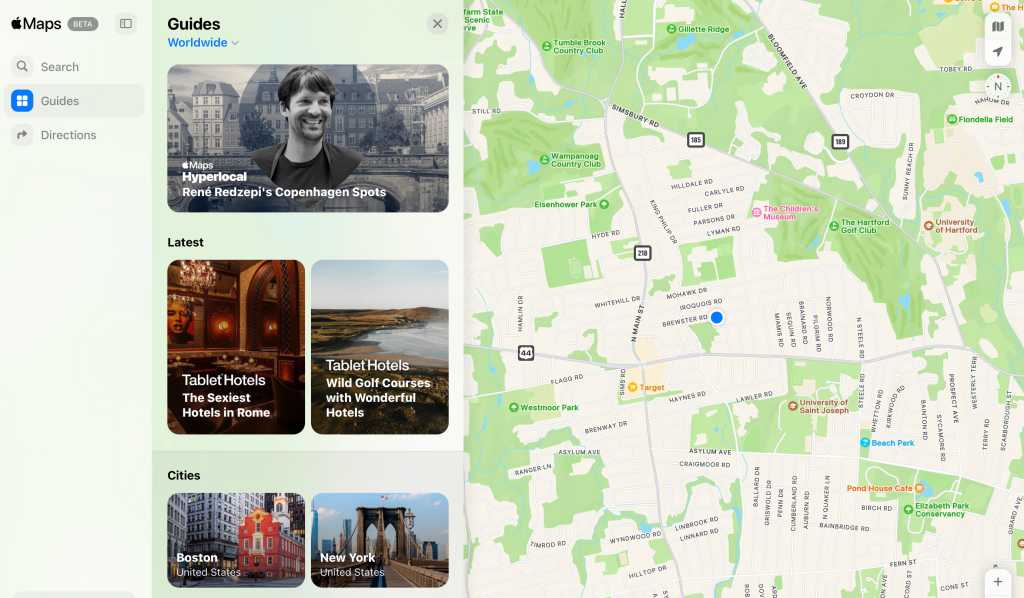
Welcome to our weekly Apple Breakfast column, which includes all the Apple news you missed last week in a handy bite-sized roundup. We call it Apple Breakfast because we think it goes great with a Monday morning cup of coffee or tea, but it’s cool if you want to give it a read during lunch or dinner hours too.
There’s a map for that
Apple dropped a bombshell last week, announcing out of nowhere the launch of Apple Maps on the web (in beta, for now). No longer will fans of Cupertino’s much-improved mapping service have to access it via Apple devices.
This is good news for the platform-agnostic public, who get more choice. But it’s a sickener for Google, which until now has had the web-based map market pretty much to itself. There have been competing services, of course, but not from any companies with comparable resources. Apple can afford to spend a lot of money making its maps as accurate, attractive, and feature-laden as possible, as demonstrated by its consistent upward trajectory from industry joke to arguably the best map service out there. Free competition is always good, and having to compete with Apple Maps on hardware platforms other than the iPhone and Mac can only encourage Google to do better—just as Apple will need to keep improving to snatch Google’s crown.
One of the areas where the two services will clash, as so often when Apple and Google are involved, is privacy. Google’s play is to offer a simple bargain: we’ll let you use Google Maps for free, but in return, we get the journey data that’s so useful for making the service better at working out optimal routes, predicting journey times, and reacting punctually to roadworks, crashes, and traffic jams. Mind you, if you think Google only uses the data to make its map service as accurate as possible, you might be interested in buying one of the bridges that Apple Maps renders in such charming 3D. Google’s entire business model is built around hoovering up user data and using it for targeted advertising. If that’s not something you like the sound of, Apple’s more hands-off approach to data could make a refreshing change.
Then again, this move raises some questions about Apple’s business model, too. Generally speaking, Apple can afford to make noble noises about privacy because it doesn’t need your data to make money; it gets the money by selling the high-end phones and computers the services run on. But if someone is using Apple Maps in Google’s Chrome browser on an Android handset… well, this might sound cynical, but where’s the revenue coming from? Isn’t this, in fact, taking away a point of difference from Apple’s own products, and fractionally reducing customer motivation to pay extra for an iPhone?
It’s possible that Apple will ensure that the web-based version of its mapping service is always slightly feature-hobbled in comparison to the one on its own hardware, and leverage it as a gateway drug: this step-by-step navigation is free, but for the full 3D imagery experience you need to buy an iPhone. But I’m not convinced that’s the play here.
Apple’s approach, in fact, may be changing in quite a fundamental way. Until now, it’s all been about the famous walled garden, an enclosed ecosystem where the company has total control: lure people in with great hardware, make it hard for them to leave by making Apple Watches only work with iPhones and iMessage unfriendly to Android, exercise iron-fist control over every aspect of the experience, then sit back and wait for the money to roll in. But that isn’t going to fly much longer, with regulators chipping away at what they view as monopolistic practices and forcing Apple to allow other companies to sell apps on the iPhone and customers to repair their own Apple products. The days of enclosed control are dying.
Apple’s future, instead, lies in the world outside its own hardware. It’s about putting CarPlay in other companies’ vehicles and selling Apple TV+ subscriptions to people who’ve never bought an Apple product; using its user-friendly software and services as a Trojan horse to sell brand value and expand the user base through mindware, not hardware. It might even, one day, mean iMessage landing on Android… but let’s take things one step at a time.
Trending: Top stories
I tried Apple Vision Pro and it made me rethink everything.
I never regretted buying an Apple device–until now.
The iPhone 16 is doomed and it’s all Apple Intelligence’s fault.
Samsung’s new Galaxy Watch and Buds are even cheaper Apple copies than we thought.
Apple’s move to RCS takes its first casualty: Samsung Messages.
The perfect Apple Intelligence device is coming–and it’s not the iPhone 16.
Google’s latest privacy changes in Chrome prove Apple’s nightmare ad is all too real.
This app shows how the MacBook’s ugly notch can be pretty useful.
Podcast of the week
The next iPhone is coming soon, so we’re seeing more reports about what to expect from Apple—not just for this fall, but for next year. It’s time for another iPhone check-in, on this episode of the Macworld Podcast!
You can catch every episode of the Macworld Podcast on Spotify, Soundcloud, the Podcasts app, or our own site.
Reviews corner
The rumor mill
The latest iPhone SE 4 rumor claims Apple now wants to make a budget iPhone 16.
Meta just filed a patent to copy Apple’s worst Vision Pro feature.
Apple’s years-long 5G modem project might finally release in 2025.
Report: At least one iPhone 17 model to feature a mechanical aperture.
Apple may shift prices upward for the iPhone 17 with a new ‘Slim’ model and ProMotion for all.
Software updates, bugs, and problems
Massive global IT outage is a perfect ad for buying a Mac.
And with that, we’re done for this week’s Apple Breakfast. If you’d like to get regular roundups, sign up for our newsletters. You can also follow us on Facebook, Threads, or Twitter for discussion of breaking Apple news stories. See you next Monday, and stay Appley.




